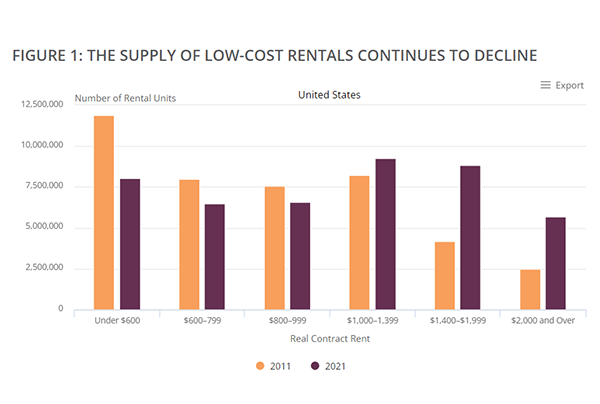
Low-Cost Rentals Have Decreased in Every State, Harvard Finds

(Source: Harvard Joint Center for Housing Studies tabulations of US Census Bureau,
American Community Survey One-Year Estimates.)
The supply of low-cost rental apartments fell by 3.9 million units over the last decade and in every state, the Harvard Joint Center for Housing studies reported.
Using data from the latest State of the Nation’s Housing report, Harvard Research Analyst Sophia Wedeen found the dwindling supply of low-cost rentals leaves lower- and middle-income renters with fewer housing options they can afford.
“The supply of low-rent units has fallen continuously in the past decade due to rent increases in existing units, tenure conversions out of the rental stock, building condemnations, and demolitions,” Wedeen said in a Housing Perspectives blog post. She said the number of units with contract rents below $600 fell from 11.9 million to 8.0 million between 2011 and 2021 adjusted for inflation. ($600 is the maximum rent amount affordable to households earning $24,000 annually.) The market lost 1.5 million units with rents between $600 and $799, the report said.
“Rent increases and high-end new construction have driven up the number of higher-cost units; the number of units renting for $1,400 or more increased by 7.8 million, to 14.5 million units in 2021,” Wedeen said. “These additions combined with the declining number of low-rent units have shifted the overall distribution of rents. Between 2011 and 2021, the share of rental units offering contract rents below $600 decreased by ten percentage points, to just 17 percent of rentals, while the share renting for $1,400 increased by 16 percentage points, to 31 percent of rentals.”
The decline in low-rent units was geographically widespread, the JCHS said. The District of Columbia and 45 states lost at least 20 percent of units with contract rents below $600 between 2011 and 2021. Among those, eight states–Arizona, Nevada, Texas, Colorado, Idaho, Oregon, Florida, and New Hampshire–lost at least 40 percent.
“Many of the states with the largest declines in low-rent units were previously more affordable places in the South that have seen increasing rental demand in recent years,” Wedeen said. She noted Texas had the largest decline, losing 512,000 units with rents below $600, which equaled half its low-rent stock. “These losses came amid significant gains at the high end, including 742,000 units renting for $1,400 or more,” she said.
